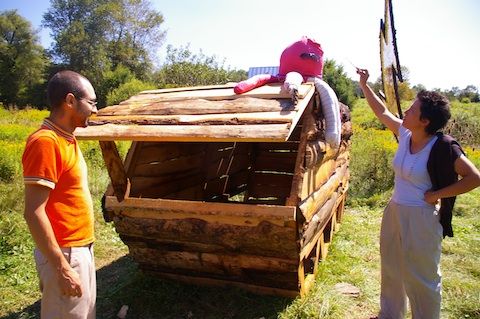
Hernani Dias and Madalyn Warren put the finishing touches on a worm composter at the Andes Sprouts Society in August.
In the mountains, you never know who is hiding out in the next hollow over. It could be a fourth-generation dairy farmer, a Sufi worship center, or a bunch of artists hatching plans to revolutionize the world's relationship with food at a place called the Andes Sprouts Society.
Most locals only recognize the Sprouts Society as a landmark – you know you’re about halfway to Andes from Margaretville in Delaware County on Rte. 28 when you see a giant silver spiral looming over a sign announcing “GARLIC.”
And indeed, during the summer months, the Sprouts Society sells garlic (and other veggies) from what members refer to as their “scrap metal farmstand.” But the main mission of the nonprofit group is to put artists, digital media mavens, techies, and farmers together to see what grows.
For example, Shu Lea Cheang, a media artist, filmmaker, and self-described “digital nomad” who is one of the owners of the 23-acre property that became the Sprouts Society in 2007, has used the garlic in her work. In 2003, she brought a truckload of it to Manhattan in an attempt to convince bystanders that the apocalypse was nigh and garlic would soon be the only legal currency.
Last year, confronted with a mundane farm chore – constructing a building – the Sprouts Society turned it into an international architectural competition for sustainable and green design, and got 78 submissions. (The winning design called for mini-greenhouses to be built into the walls and construction components that could be lifted into place by just a few people.)
 The scrap metal farm stand
The scrap metal farm stand
This year, the Sprouts Society got funding from the New York State Council on the Arts to create a formal artist residency program that promotes these kinds of heady mixtures of farming, media, and art. The residency runs alongside the Society's organic farming operation, and the idea is to have cross-pollination, with artists farming and farmers making art, says Madalyn Warren, a farmer from nearby Roxbury who runs the Sprouts Society with Cheang and activist filmmaker Dee Dee Halleck.
“Both kind of inform each other,” Warren says. “We'd like to see how the two [programs] converge here, and see what kind of projects evolve from that.”
Buffalo media artist, food systems critique, and teacher Stefani Bardin and Portuguese urban farming organizer Hernani Dias were the first artists in the program. Both spent several weeks in Andes this summer, and plan to be back later this year. Recently, the Watershed Post got a peek at both of their projects.
One aims to illuminate junk food's journey within. The other hopes to put a micro-farm in every city-dweller's apartment.
The Fantastic Voyage
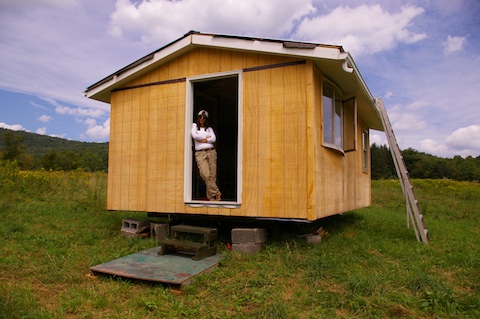 Stefani Bardin, in the Sprouts Center's artist's residenceThere are two ways to kill a goat, Stefani Bardin says. One of them involves the stench of “blood and metal and cold” in an industrial slaughterhouse. The other, she says, is "biodynamic," and comes with a very different smell. Witnessing that second kind of slaughter last fall at the Sprouts Society, Bardin says, changed her life.
Stefani Bardin, in the Sprouts Center's artist's residenceThere are two ways to kill a goat, Stefani Bardin says. One of them involves the stench of “blood and metal and cold” in an industrial slaughterhouse. The other, she says, is "biodynamic," and comes with a very different smell. Witnessing that second kind of slaughter last fall at the Sprouts Society, Bardin says, changed her life.
“It smelled really good,” Bardin says. “It was so humane. They talked to the goat. They petted the goat. They held the goat when they slitted her throat. I stuck my nose in the carcass.”
The experience gave Bardin an idea for an art exhibit: a piece that both shows and smells the difference between industrial slaughtering and hands-on ways of killing animals.
“I thought, ‘God,’ if everybody could experience this, it would completely shift their relationship [to meat],” she says.
On her computer, Bardin pulls up a potential images for the installation: a vivid photo of crimson blood dripping from a metal walkway inside a meat-packing plant.
“I want the photos to be so visually arresting that they can't look away,” she says. “I want people to smell the difference between the two.”
Bardin, who teaches a seminar called “Food and Emerging Media” at the University at Buffalo, uses art installations, often stocked with this kind of stomach-turning imagery, to make passionate arguments on behalf of real, unadulterated food. She also relies on smells to make her point, sometimes literally piping artificial scents into a gallery space as part of an exhibit. (The goat installation, for example, will include smells of slaughter.)
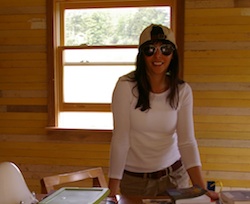 Bardin in her studioWhile the Sprouts Society has inspired the work-in-progress about slaughter, most of Bardin's time in Andes is being spent on another project, called “No Nutritional Value.”
Bardin in her studioWhile the Sprouts Society has inspired the work-in-progress about slaughter, most of Bardin's time in Andes is being spent on another project, called “No Nutritional Value.”
Bardin refers to it as the “junk food project.” It will be a walk-through installation of two real-life digestive tracts as they eat two very different meals: a healthy one made of foods raised by Catskills farmers, and a junk food one made up of blue Gatorade and pink Hostess Sno Balls.
To get footage of the meals as they are digested, two volunteers will swallow two tiny pills each -- one equipped with a tiny light and a video camera, and the other with a battery of sensors to detect pH levels and digestion speed.
The final exhibit will include smells of the two meals (thanks to piped-in artificial fragrances), videos of the food as it passes, in full Technicolor, through the stomach, and music that represents the pH readings in the intestines translated into sound.
“We're creating a GI symphony,” Bardin says.
This real-life Fantastic Voyage is quite an undertaking -- Bardin has spent the past four years attempting to convince various gastroenterologists to help her. (She finally got the skeptical assistance of one at Harvard, whom she won’t name.) The specifics of when and where the exhibit will debut are still being nailed down, but Bardin's plan is to show it as widely as possible.
Her goal, Bardin says, is to jolt people into thinking about what they eat.
“It's shocking how little people know about their food,” she says.
During the three weeks Bardin spent at the Sprouts Society this summer, she helped harvest vegetables at the Cooked Goose Farm in Roxbury, which will supply her healthy Catskills meal for her installation. She also visited the Pakatakan Farmers' Market, which reminded her of all that is wrong in our nation's food system.
“I went to the Round Barn, and what I found so fascinating about that was that the local people can't afford to buy food there,” she says. “I saw a ton of yuppies moving their way through and avoiding food that was dirty. I want food that is dirty – that's how I know that it was in the ground.”
Inequality and ignorance when it comes to food visibly infuriates Bardin. She chooses to respond in the form of art instead of, say, agricultural policy because, she says, to make change you have to hit people in the gut.
“There's so much information that's contradictory, and so much false information, that people get blocked,” she says. “Hopefully, what I'm doing is breaking through that. [I am trying to] present this information in a way that’s visually arresting, and olfactorily arresting.”
“People should be angry,” she adds. “I cannot believe they're not angry.”
Farmville, offline
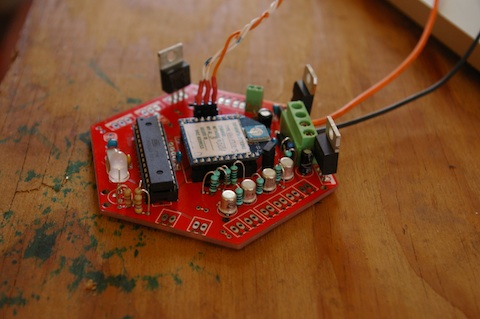 A ReFarm circuit boardHernani Dias (his full name is Hernani Jose Silva Carvalho Dias) came to farming as an absolute novice, when he moved from his home in Portugal to Barcelona, in Spain, and decided to begin growing a few vegetables in his city apartment.
A ReFarm circuit boardHernani Dias (his full name is Hernani Jose Silva Carvalho Dias) came to farming as an absolute novice, when he moved from his home in Portugal to Barcelona, in Spain, and decided to begin growing a few vegetables in his city apartment.
“When I got there, I saw that I didn't have the vegetables for my recipes,” he says. “My sister is a biologist, and I asked her, 'Can you send me some seeds?' She sent me some seeds, and during that year I was an urban farmer.”
Then, like most city folks do, Dias went on vacation.
“When we came back, everything was dead,” he says.
Dias realized that if his urban farm was going to survive, it needed a reliable source of water when he wasn’t there. Dias went shopping for automatic watering systems, but found nothing that satisfied him.
“[The system I found] was like a clock for watering,” he says. “That's not what I want. I want something that says, ‘This plant needs water, so I'll water it.’”
So, in true DIY fashion, he created a simple piece of electronics to solve the problem. These hexagonal pieces of solder-your-own hardware and software can be configured to do a lot of the simple tasks of farming, remotely.
“This board can control a watering system,” Dias says. “It has sensors for the temperature, moisture, and light. So with these parameters, I can make an intelligent system of watering the plants, and send this data to the internet, so when you are on the internet, you can connect and see how your farm is doing.”
(Dias isn't the only person developing digital methods of farming; MIT is experimenting with robot-farmers as well.)
 Dias and his scarecrowOnce he had the hardware, Dias realized that his urban farming career still needed help. Thus was born the ReFarm the City project, essentially a loose-knit community of about 30 urban farmers based in cities around the world and connected by a website, refarmthecity.org. Members in each city interact with others in their city “node,” swapping advice and recipes as they garden throughout the year. Dias's visit to New York culminated in the birth of a NYC ReFarm outpost, which will be connected to the Sprouts Society year-round. (You can read about the NYC group on its blog here.)
Dias and his scarecrowOnce he had the hardware, Dias realized that his urban farming career still needed help. Thus was born the ReFarm the City project, essentially a loose-knit community of about 30 urban farmers based in cities around the world and connected by a website, refarmthecity.org. Members in each city interact with others in their city “node,” swapping advice and recipes as they garden throughout the year. Dias's visit to New York culminated in the birth of a NYC ReFarm outpost, which will be connected to the Sprouts Society year-round. (You can read about the NYC group on its blog here.)
Dias, who worked as a graphic designer before his foray into urban agriculture, is building online tools to help his far-flung community of gardeners around the world. Want to make gazpacho from scratch -- really from scratch? Plans are in the works for a program that will take you from recipe to seeds to harvest to table.
Its emphasis on online collaboration makes ReFarm a bit like the popular Facebook game Farmville – except with real vegetables.
Dias acknowledges that comparison, and says that he hopes the popularity of Farmville will push more Facebook junkies to start getting their hands dirty in the real world.
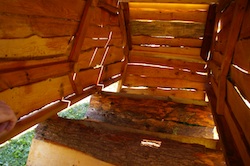 Inside the composterOne of Dias's projects in Andes is a large, hexagonal wooden compost bin. The bin, made of pieces of wood salvaged from a sawmill in Andes, was built by the New York City ReFarm volunteers in August, and Dias finished it off by installing a battery of sensors to measure the heat inside and outside the bin throughout the winter. The sensors are housed in a large stuffed octopus Dias calls a “scarecrow.” The idea is to test the electronic sensors in a hard winter while making a batch of excellent soil that the NYC ReFarm group can take back to their micro-farms at home. (The octopus casing is both for insulation and for fun.)
Inside the composterOne of Dias's projects in Andes is a large, hexagonal wooden compost bin. The bin, made of pieces of wood salvaged from a sawmill in Andes, was built by the New York City ReFarm volunteers in August, and Dias finished it off by installing a battery of sensors to measure the heat inside and outside the bin throughout the winter. The sensors are housed in a large stuffed octopus Dias calls a “scarecrow.” The idea is to test the electronic sensors in a hard winter while making a batch of excellent soil that the NYC ReFarm group can take back to their micro-farms at home. (The octopus casing is both for insulation and for fun.)
“If people don't have soil, and here we have so much soil, why not connect people here with the land in Andes?” Dias says. “Because here, the winter is very, very hard. We will try to understand if the electronics weather the winter; if the sensors get rusty during the winter.”
In between building sensors and managing the far-flung communications of the ReFarm organization, Dias spent his stay in the Catskills marveling at the differences between European and American food traditions.
“I'm quite surprised by [the fact that] there are not a lot of recipes [in America],” he says. “What you can you do with a rabbit? You can do three things over here. In Portugal, you have at least 400 recipes for a rabbit.”
Dias did discover a New World food that he's going to miss: blackberries.
“I didn't know them,” he says. “We have berries that are exactly like these, but they are white. We [picked] some, and then made some jam with them put it on lamb. I had never tasted lamb with berries.”
For more info on the Andes Sprouts Society, Stefani Bardim, or the ReFarm the City project, check out their extensive websites, all linked here. All photos in this story by Julia Reischel.










